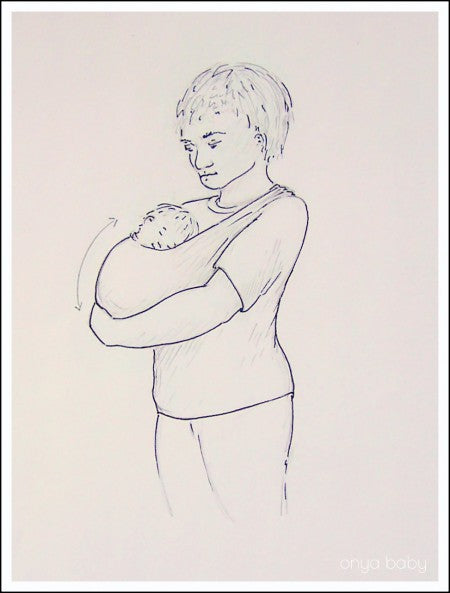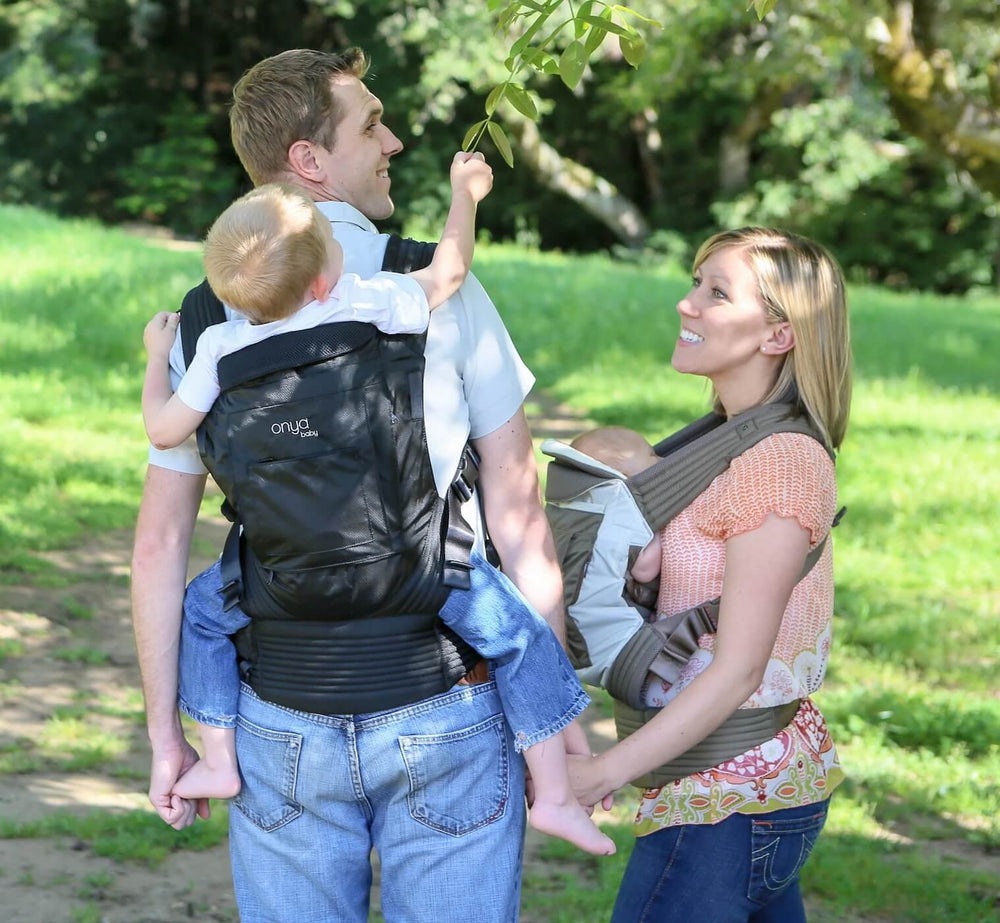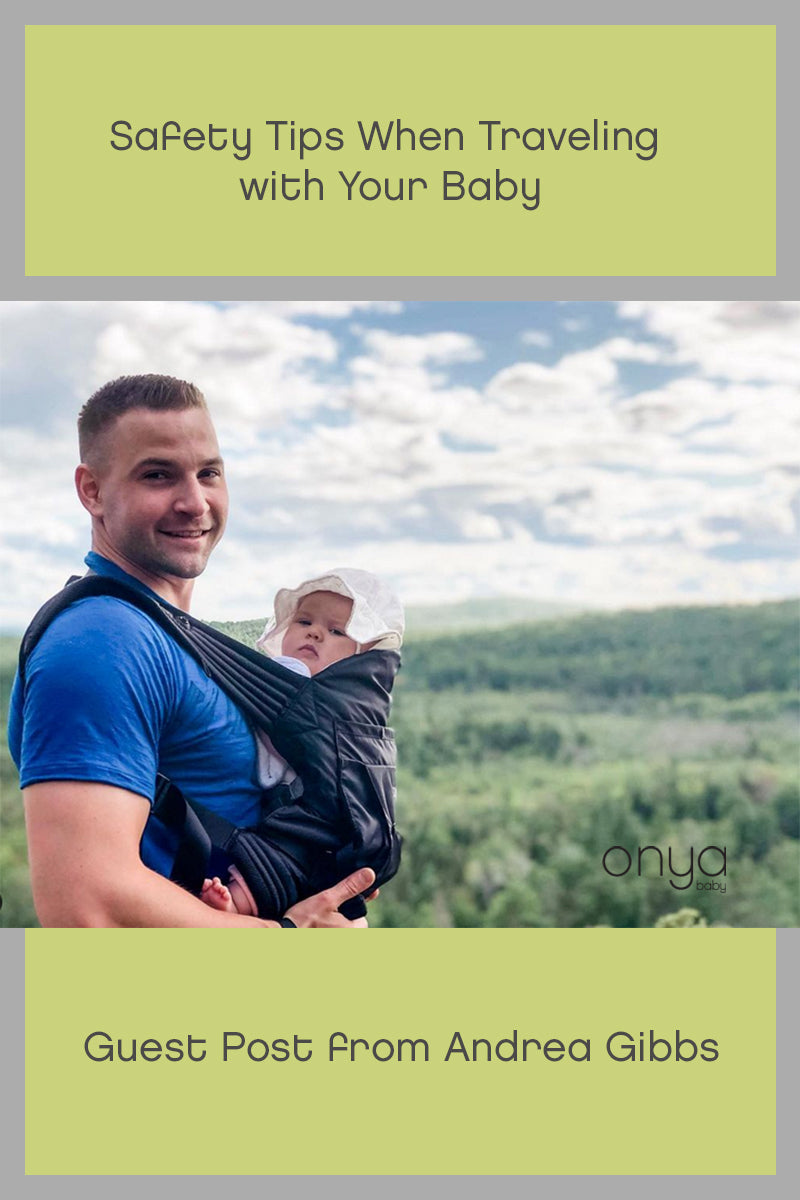Benefits of Babywearing vs. Carseat Carrying

Dr. Andrew Dodge, DC
As a chiropractor that treats mostly expectant mothers and children, I see both baby-wearing and car seat carrying parents on a daily basis. I work with several other doctors in a clinic outside of Forth Worth, Texas, and collectively, we see much more car seat carrying than baby-wearing, and we try to discourage our patients from using their car seats outside of the car. Baby seat companies have made it incredibly easy for parents to transport their child in a car seat from house to car to final destination without ever having to move baby. It is such an easy thing to do, and with many families with multiple kids and crazy schedules rushing from here to there, I completely understand and sympathize with parents that choose to carry their kids this way. There are, however, many reasons why both my wife and I, as parents, and my colleagues and I, as doctors, do not recommend this type of baby carrying. We will take a look at why baby wearing is one of the best things you can do for optimal structural, neurological, physiological, and emotional development for baby.

A newborn’s spine in proper c-shaped alignment
Structurally, your newborn baby’s spine is a big c-shape. Their posture is completely flexed, just like they were inside the womb. As their postural muscles get stronger, they are able to hold their head up and your baby develops the proper curve in their neck. Likewise, as baby begins to move around and crawl, they develop the proper curve in their low back. These curves develop over the first year of the baby’s life and are important for your baby’s developing spinal cord and nervous system, as well as their spinal joints and hip joints. When babies are worn properly by their parents and/or other caregivers, they are in a better biomechanical position for spinal and muscular development. In the properly worn position, gravity will aid in the development of postural muscle tone.
In contrast, when baby is laying flat on their back in a car seat for a prolonged amount of time, the gravitational effects on the spine begin to straighten the developing curves. With prolonged time on their backs, babies can also begin to develop plagiocephaly (or flattening of the bones of the skull) causing deformation.[i] Both of these changes can affect proper spinal joint alignment and weight-bearing biomechanics, ligament development and strength around the spine and hip joints, muscle tone and biomechanical development, and neurological development of the child.[ii] Shorter amounts of time will not ultimately lead to drastic changes, but limiting the time your baby is in the car seat is structurally what is best for your baby. So put them in the car seat when they are in the car, but when you get to where you are going have a wrap, sling, or soft structured carrier ready to go! This way you can keep hands free and give awesome support to your little one’s developing body.

Neurologically, there has been shown to be accelerated brain maturation when infants are worn.[iii][iv][v] When your baby is being worn there is constant movement in all directions. Baby-wearing gives a huge amount of input into the baby’s vestibular system (the balance centers in the brain). This movement not only helps to build those neurological pathways, but it also helps to build the part of the brain that gives tone to the core musculature and intrinsic spinal muscles that give the body the ability to balance, coordinate, and stabilize itself with simple or complex movements.[vi] These are the first centers in the brain to develop and grow, laying down the foundation for the rest of brain and body development. If this foundation is not strong, other parts that are built on top may not be as strong or developed as they could have been. Furthermore, wearing your baby gives them the best way to see, hear, and interact with the world around them. Baby can look at all of the colors and movements, watch social interactions between their parents and others, and see facial expressions during conversation while feeling safe and secure close to mom or dad. All of those things that seem so insignificant can have a huge effect on your baby’s developing brain. Plain and simple: the more they experience, the more their brain develops.

The more your baby experiences, the more your baby’s brain develops
On the contrary, when baby is spending prolonged amounts of time in the car seat (even with the ability to hold their head up), it is very difficult for baby to see much of the world around them. They see only what they are set in front of. The only movement that baby gets is when the car seat is picked up and moved from one spot to the next. Baby does not experience constant variable motion like when baby is being worn. From the standpoint of brain development, babywearing is definitely the better option. Physiologically and emotionally, babies, especially newborns, can rely on their parents’ physiology and emotions to help regulate their own. When baby is worn with consistency, parents can more easily pick up on little cues that their child has (i.e hungry, tired, over-stimulated, too hot, too cold, etc). When changes in physiology happen in baby, they in turn cause physiological changes in mom or dad to help regulate themselves. When your baby is close to you they can regulate their breathing rate, heart rate, body temperature, emotions, stress levels, and immunity levels.[vii] This is one reason why kids become “clingy” when they get sick. While being close to you, your child can increase antibody production and increase their body temperature to fight off illnesses. In a chapter she wrote in the Behavioral Management of Health from Preconception to Adolescence, Dr. Maria Blois, MD examined the research relating to physiological changes that occurred when babies were worn and concluded, with citation of fourteen separate studies, that:
There is strong evidence to support the use of kangaroo care [baby wearing with skin-to-skin contact] for preterm babies with benefits that include shortened hospital stay, decreased morbidity, higher exclusive breastfeeding duration, increased weight gain, improved state regulation, and improved maternal sense of competence. Evidence-based benefits of KC for term babies included improved state organization and motor system modulation; improved extrauterine temperature adaptation; and an analgesic effect… Simple holding, without the skin-to-skin contact, was found to reduce crying, and the provisions of soft carriers led to mothers who were more responsive to their babies and to babies who were more securely attached. [viii]

Being able to connect on such an intimate physiological and emotional level allows moms and dads both to nurture a deep and lasting bond with their children.[ix] Without holding your babies close and wearing your children these physiological and emotional connections do not take place. Car seats cannot help regulate your child’s temperature, improve their immune function, help them to gain weight, calm them and reduce stress levels.[x]
When it comes to baby-wearing and car seat carrying there is really no comparison. Baby wearing from every developmental aspect is far superior. For short term uses the car seat is not going to be terribly detrimental to baby’s development, but given the option, when the car stops, the car seat stays in the car and I am putting a carrier on and wearing my child.
About Dr. Andrew Dodge, DC
Dr. Andrew currently lives outside of Fort Worth, Texas, with his wife Nicole and their 9-month-old son Luke. He is a chiropractor in a family clinic in the area, treating mostly expectant mothers and children. He is opening his own clinic in the beautiful Shenandoah Valley of Virginia this fall, where their children will be able to grow up around extended family. In addition to his doctor of chiropractic degree, he is also in the process of certifying for a diplomate in neurology as well as an advanced certification in pediatric care. Dr. Andrew and Nicole are enthusiastic babywearing advocates and will be establishing the Shenandoah Valley’s first babywearing library!
[i] Timothy Littlefield, et al., “Car Seats, Infant Carriers, and Swings: Their Role in deformational Plagiocephaly,” Journal of Prosthetics & Orthotics 15 (July 2003): 102-106.
[ii] Barney F. LeVeau and Donna B. Bernhardt, “Developmental Biomechanics: Effect of Forces on the Growth, Development, and Maintenance of the Human Body,” Physical Therapy 64 (December 1984): 1874-1882.
[iii] Mark S. Scher, et al., “Neurophysiologic Assessment of Brain Maturation after an Eight-Week Trial of Skin-to-Skin Contact on Preterm Infants,” Clinical Neurophysiology 120 (October 2009): 1812-1818.
[iv] Esmot Ara Begum, et al., “Cerebral oxygenation responses during kangaroo care in low birth weight infants,” BMC Pediatrics 8 (November 2008).
[v] Rejean Tessier, et al., “Prematurity and Morbidity: Could KMC Reverse the Process?,” Current Women’s Health Reviews 7 (August 2011): 254-261.
[vi] MW Morningstar, et al., “Reflex control of the spine and posture: a review of the literature from a chiropractic perspective,” Chiropractic And Osteopathy 13 (August 2005).
[vii] Susan M. Ludington-Hoe, “Evidence-Based Review of Physiologic Effects of Kangaroo Care,” Current Women’s Health Reviews 7 (August 2011): 243-253.
[viii] Maria Blois, “Birth: Care of Infant and Mother: Time-Sensitive Issues,” in Will Gordon and Jodie Trafton, ed. Best Practices in the Behavioral Management of Health from Preconception to Adolescence (Los Altos, CA: IBP, 2007), 108-132.
[ix] R Tessier, et al., “Kangaroo Mother Care, home environment and father involvement in the first year of life: a randomized controlled study,” Acta Paediatrica 98 (September 2009): 1444-1450.
[x] S Mooncey, X Giannakoulopoulos, and V Glover, “The effect of mother-infant skin-to-skin contact on plasma cortisol and beta-endorphin concentrations in preterm newborns,” Infant Behavior & Development 20 (October 1997): 553-557.








